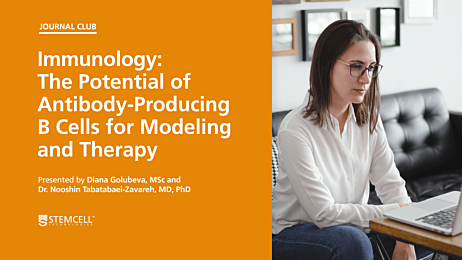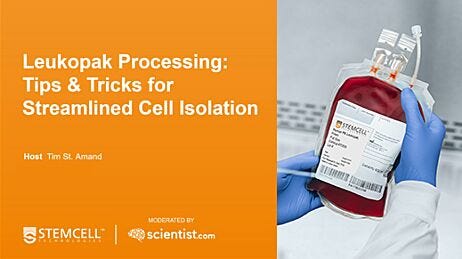Human B Cell Isolation, Expansion, and Analysis
B cells are antibody-producing immune cells that are used to study various infectious diseases, autoimmunity, and cancer. The in vitro culture and expansion of these cells is a useful tool for studying human immunity, B cell biology, vaccine and therapeutic antibody development, and for uncovering their potential use in cell therapies.
To help keep researchers moving forward, STEMCELL Technologies has developed products that support the complete experimental workflow; from cell sourcing and isolation to expansion and analysis (Figure 1). Here you can get some tips and tricks on how best to obtain high yields of B cells for your research.
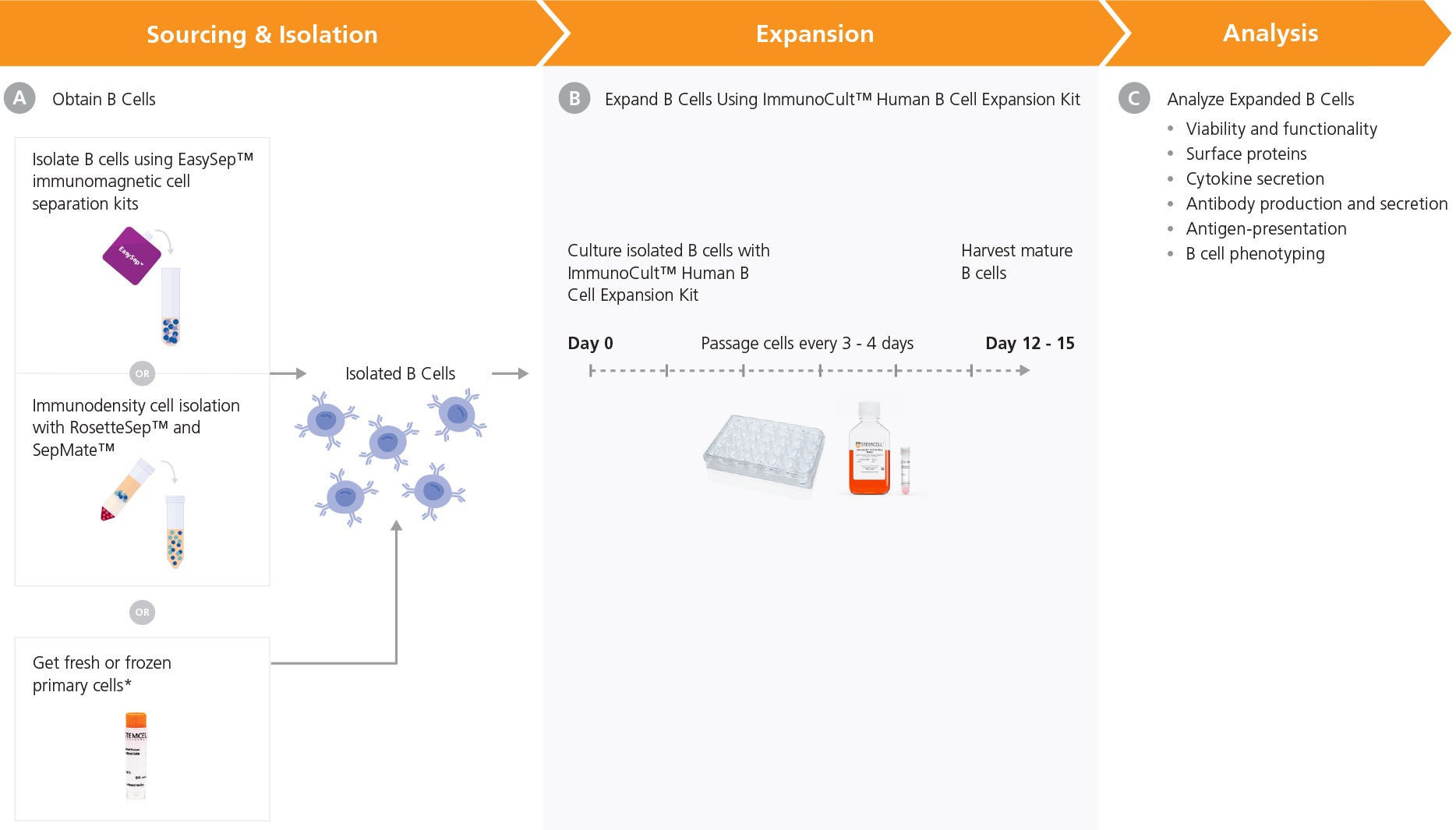
Figure 1. Integrated Workflow for Obtaining and Culturing Human B Cells
(A) Isolate B cells from fresh human whole blood or leukopaks using EasySep™ cell separation kits or RosetteSep™ enrichment cocktails. Fresh or frozen human primary B cells can also be sourced directly from STEMCELL and immediately cultured in ImmunoCult™. (B) Expand and harvest mature B cells by culturing the isolated B cells with ImmunoCult™ Human B Cell Expansion Kit for 12 - 15 days. Passage cells every 3 - 4 days and harvest B cells for use in downstream applications. (C) Analyze B cells using STEMCELL’s antibodies, ELISA kits, and cell dyes.
*Certain products are only available in select territories.
Source and Isolate Human B Cells
Human B cells can be purchased directly or isolated from sources such as whole blood, leukopak, peripheral blood mononuclear cells (PBMCs), and spleen using EasySep™ cell separation kits or RosetteSep™ enrichment cocktails. B cells isolated with these methods are of high purity and are immediately ready for expansion, analysis, or for use in other downstream applications.
Source Primary Human B Cells
Streamline your assays with ready-to-use human B cells isolated by positive or negative immunomagnetic selection from peripheral blood or cord blood. We help you get the cells you need with personalized service, custom products, flexible delivery times, and the option to reserve entire lots to prescreen cells for your applications*.
For more information about primary cells, please see our frequently asked questions.
See all human primary cell products >
*Certain products are only available in select territories.
Pro Tip by Trevor Rogers, Research & Development, STEMCELL Technologies
Cell counting is an integral part of determining cell concentrations for plating in culture, determining cell viability, and assessing the results of cell isolation procedures. It is recommended to perform an initial cell count prior to cell isolation; this number can then be compared to the cell count after cell isolation to calculate cell recovery. Additionally, viable cell counts should be performed when a decrease in cell viability may be expected, for example, when working with cryopreserved cells or cells manipulated ex vivo.
Start Your Workflow by Isolating B Cells Using EasySep™
For experiments that require a high purity of B cells, it is necessary to enrich the samples before progressing to cell culture or expansion. EasySep™ is a fast, easy, and column-free immunomagnetic cell separation system for isolating highly purified cells. Below is a representative flow cytometry plot showing the content of pan-B cells in a sample enriched with EasySep™ Human Pan-B Cell Enrichment Kit.
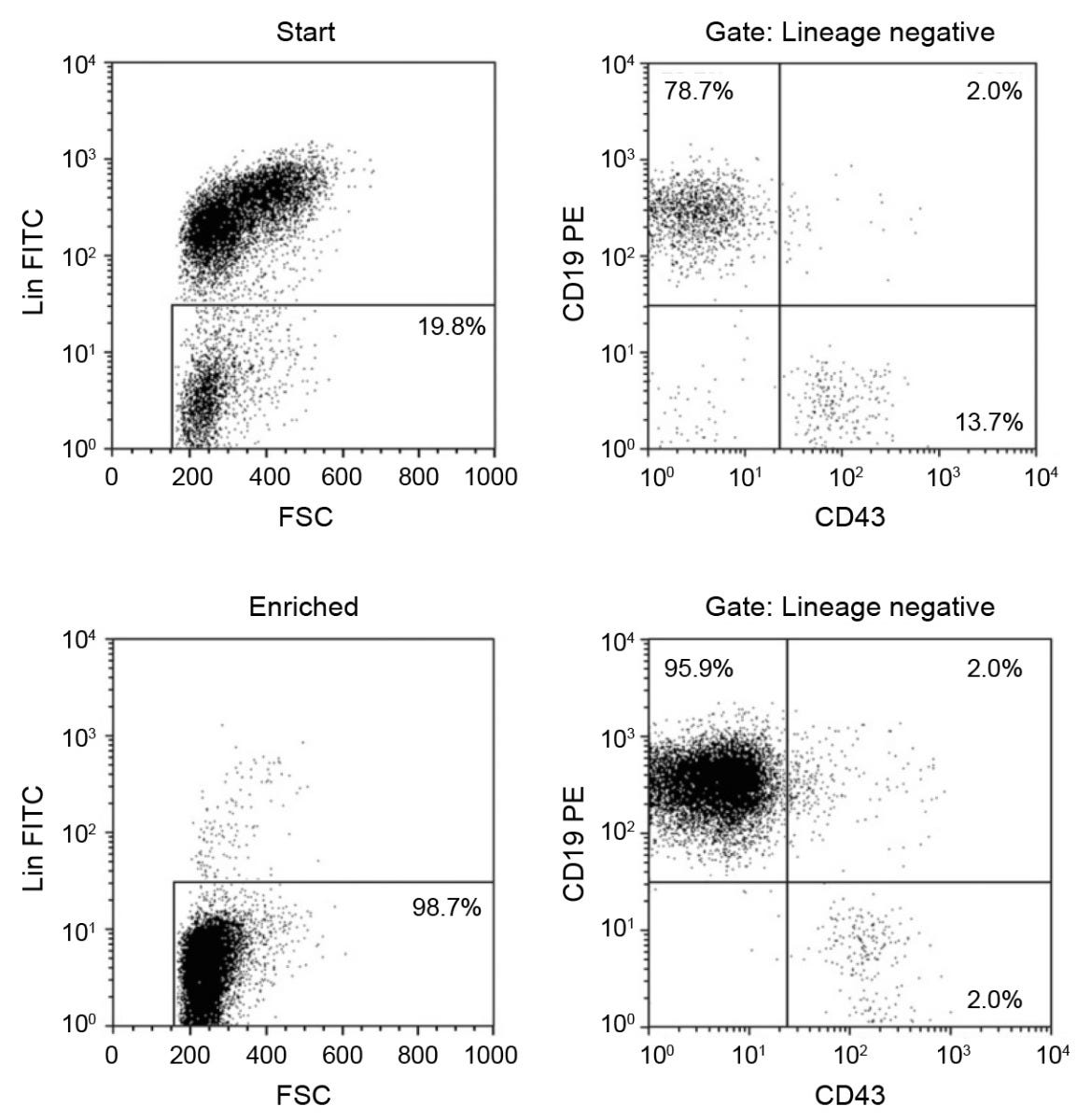
Figure 2. EasySep™ Human Pan-B Cell Enrichment Kit Isolates Pan-B Cells with High Purity
Representative flow cytometry plots gated on viable cells isolated with EasySep™ Human Pan-B Cell Enrichment Kit. Starting with nucleated cells, the pan-B cell [Lineage (CD4, CD8, CD14, CD16, CD56) negative, CD19+ and CD19-CD43+] content of the enriched fraction typically ranges from 90 - 99%.
EasySep™ enables us to isolate B cells from the spleen really fast with good viability. That is what we need. You don’t have to stand in front of a column and wait for it to drip. The viability of the cells that you recover tends to be higher just because it is so fast.
Steevenson N., PhD, National Institutes of Health
There are several different B cell isolation kits available, depending on your starting sample and your cell population of interest. EasySep™ Human Memory B Cell Isolation Kit is designed to isolate CD27+ Memory B cells from fresh or previously frozen PBMCs, while EasySep™ Direct Human B Cell Isolation Kit and EasySep™ Direct Human Naïve B Cell Isolation Kit allow for cell separation directly from whole blood. You can also perform immunodensity cell separation by using RosetteSep™ and SepMate™ without any specialized equipment beyond a centrifuge; this method can be easily incorporated into established density gradient centrifugation protocols. A complete overview of all STEMCELL’s cell isolation products for B cells can be viewed in the infographic below.
Unsure which human B cell isolation product is right for your research? Explore this infographic to find the product suited to your starting sample and B cell subsets of interest.
If you are curious to learn more about EasySep™ and see how it performs in your lab, you can request a free EasySep™ sample here.
Find more resources on cell separation technology:
- E-Book Cell Separation Techniques–Everything You Need to Know
- Video How EasySep™ Magnetic Cell Separation Technology Works: Fast and Easy Cell Isolation
- Infographic Human B Cell Research
- Video How to Speed up Your PBMC Isolations with SepMate™
- Immunology Feature The Role of Memory B Cells in Infectious Diseases
- Video Automate Cell Isolation with the RoboSep™-S Cell Separation Instrument
Can't Find the Cell Isolation Kit You Need?
If you're working with unique or rare B cell subsets in your research but can't find a readily available cell separation kit, explore our custom cell separation products for solutions tailored to your exact research needs. Contact Product & Scientific Support at techsupport@stemcell.com to discuss your specific cell separation needs or connect with us on LiveChat.
Culture Human B Cells with ImmunoCult™
B cells sourced from STEMCELL or isolated with EasySep™ are highly purified and immediately ready for cell culture. Achieving robust expansion of B cells in culture typically requires the addition of serum or feeder cells. Addition of serum can improve performance, albeit with high lot-to-lot variability in the composition of the serum and the risk of contamination by adventitious agents. To minimize this variability, it is important to use serum-free medium and supplements, such as ImmunoCult™-XF B Cell Base Medium and ImmunoCult™-ACF Human B Cell Expansion Supplement. To achieve the most optimal expansion, use the ImmunoCult™ Human B Cell Expansion Kit, which is designed to give high cell yield and frequency without the use of serum, specialized cultureware, or feeder cells.
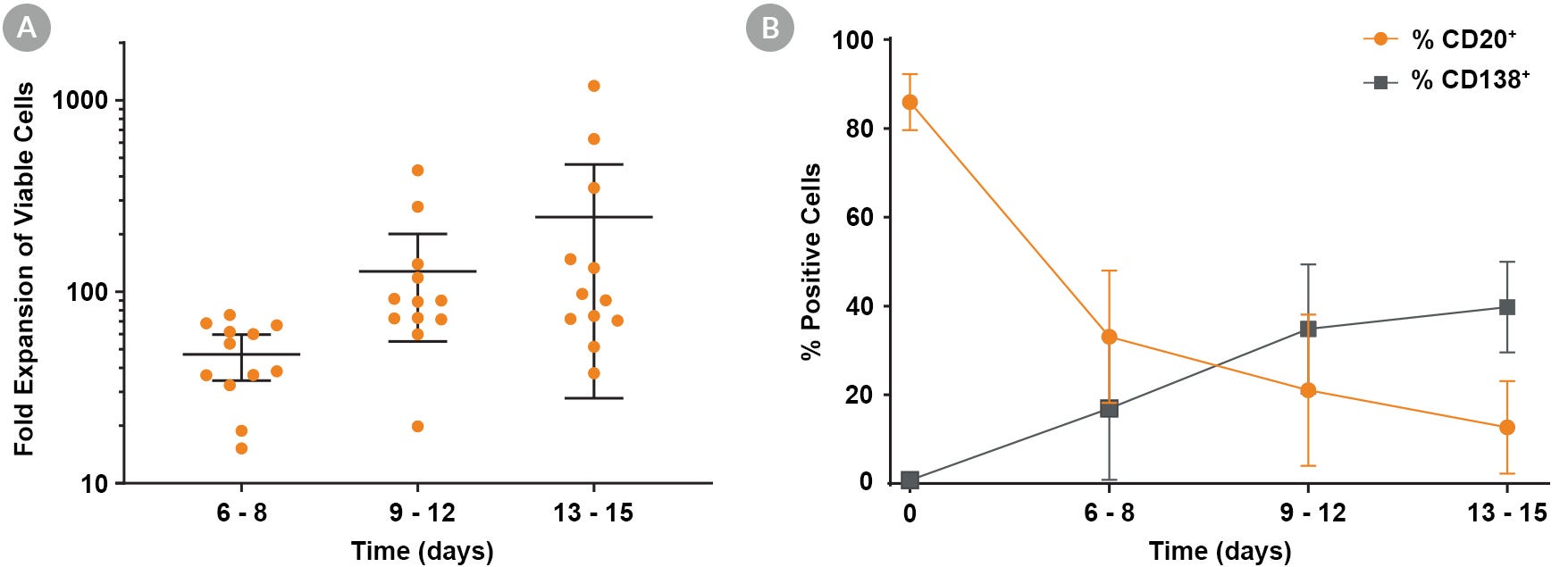
Figure 3. Culture B Cells with ImmunoCult™ Human B Cell Expansion Kit
B cells isolated from human PBMCs (leukopak) using EasySep™ Human Pan-B Cell Enrichment Kit were seeded at 1 x 105 cells/well in 24-well tissue culture plates and cultured using ImmunoCult™ Human B Cell Expansion Kit. The cells were passaged every 3 - 4 days. (A) Fold expansion of viable cells is shown for n = 12 donors, with bars representing the mean and 95% confidence level (range: 38- to 1190-fold at day 14 ± 1 day). (B) Expression of CD138 and CD20 was analyzed by flow cytometry at each timepoint (data represent % positive viable cells; mean ± 1 SD). The observed changes indicate maturation of B cells to plasma cells/blasts.
View the performance data for expansion of naïve and memory B cells using ImmunoCult™ Human B Cell Expansion Kit.
Pro Tips by Hitesh Arora, Research & Development, STEMCELL Technologies
- To ensure high cell viability and expansion, passage cells every 3 - 4 days and avoid letting cultures become over-confluent
- To avoid introducing error in cell counts due to local variation in cell density, cells should be well-mixed before counting
- Do not disturb the cells while in the incubator between passaging steps; this can affect B cell clustering
- Always perform the experiment in sterile conditions
Applications
- Antibody development and screening
- Studies on human immunity and infectious diseases
- Vaccine development
- Gene editing
- Research in understanding B cell biology, signaling, differentiation, and development
Analyze and Characterize B Cells
Expanded B cells can be used in downstream applications and may be analyzed and characterized using techniques such as flow cytometry, ELISA, microscopy etc. Figure 4 below shows how B cells undergo morphological changes as they mature.
Evaluate B Cell Culture

Figure 4. Robust Growth of Human Pan-B Cells Cultured with ImmunoCult™ Human B Cell Expansion Kit
Pan-B cells isolated from human PBMCs (leukopaks) were seeded at 1 x 105 cells/well in a 24-well tissue culture plate with ImmunoCult™ Human B Cell Expansion Kit. The cells were passaged on day 4 after seeding and imaged at (A,C) 20X, (B) 2X, or (D) 40X objective, 6 days after seeding. At (A) Day 0, B cells appear small and not clumped together; however, at (B, C, D) Day 6, B cells form large colonies and increase in size, suggesting they are undergoing activation and maturation.
Analyze
- Viability and functionality
- Surface proteins
- Cytokine secretion
- Antibody production and secretion
- Antigen presentation
- Cellular phenotyping
Assess Phenotype of Mature B Cells
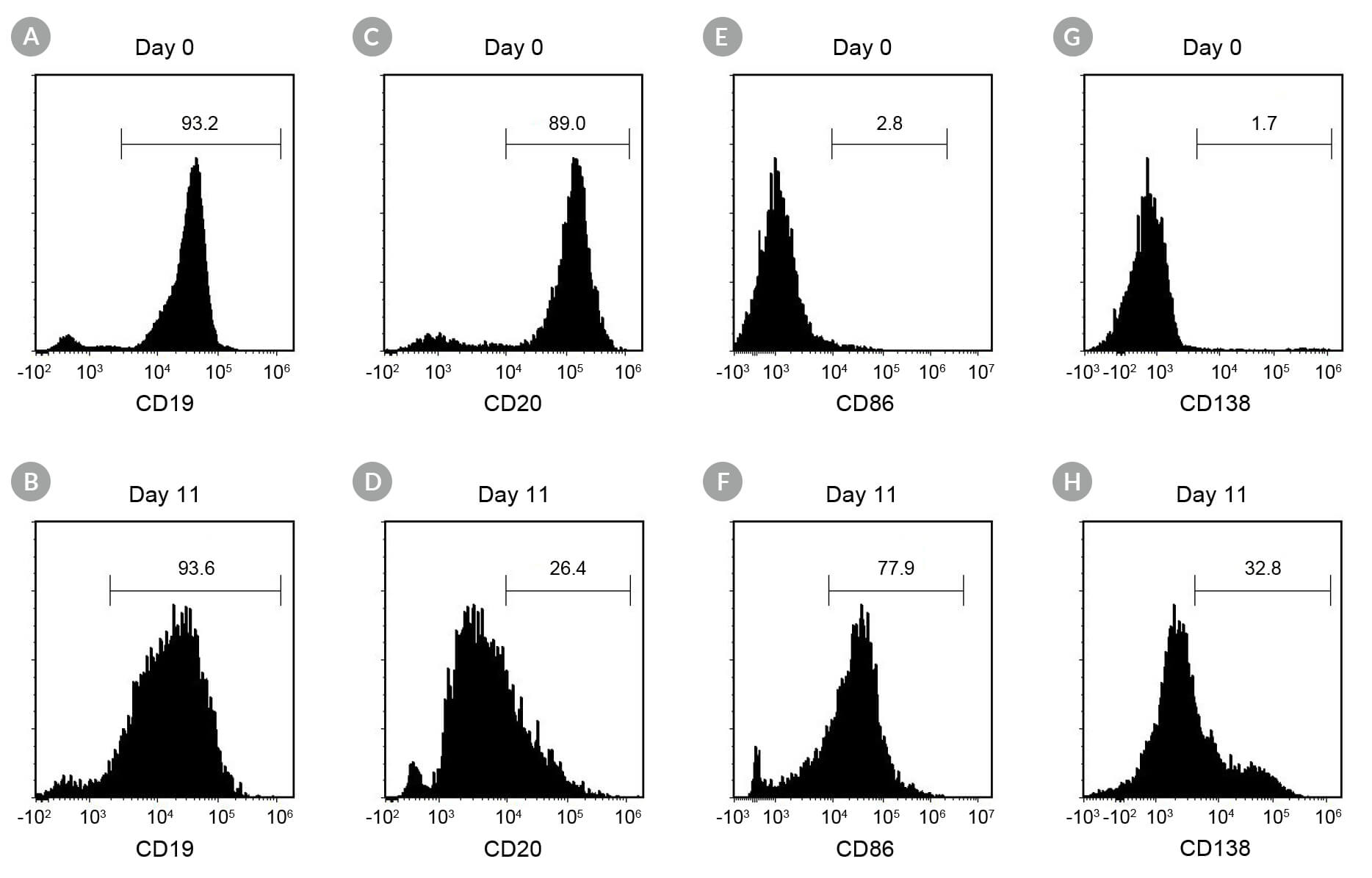
Figure 5. Expression of Activation and Maturation Markers on Human B Cells Cultured with ImmunoCult™ Human B Cell Expansion Kit
B cells isolated from human PBMCs (leukopak) using EasySep™ Human Pan-B Enrichment Kit were seeded at 1 x 10^5 cells/well in 24-well tissue culture plates and cultured using ImmunoCult™ Human B Cell Expansion Kit. The cells were passaged every 3 - 4 days. Expression of CD19 (A, B), CD20 (C, D), CD86 (E, F) and CD138 (G, H) was analyzed by flow cytometry, with profiles shown at Day 0 (upper panel) and Day 11 (lower panel). The observed changes indicate activation (CD86) and maturation (CD20, CD138) of B cells to plasma cells/blasts.
Pro Tips by Mourad Van Hove, Scientific Support, STEMCELL Technologies
To ensure success when you characterize your B cells using flow cytometry, there are a number of factors to consider and incorporate into your staining and gating strategy:
- Compensate for spectral overlap
- Use appropriate gating controls
- Exclude debris and non-viable cells
- Exclude doublets or multiplets
- Stain with a pan-leukocyte marker (e.g. CD45)
If you need antibodies for your B cell characterization, you can view our inventory via the link below:
Need help with setting up your experiments or want to chat with one of our experts? Get in contact with us here via LiveChat or send us an email at techsupport@stemcell.com.


